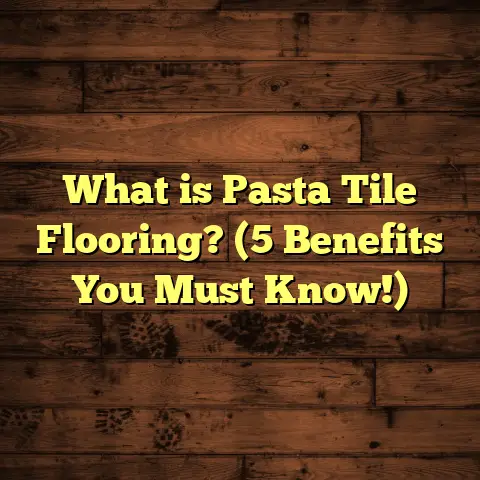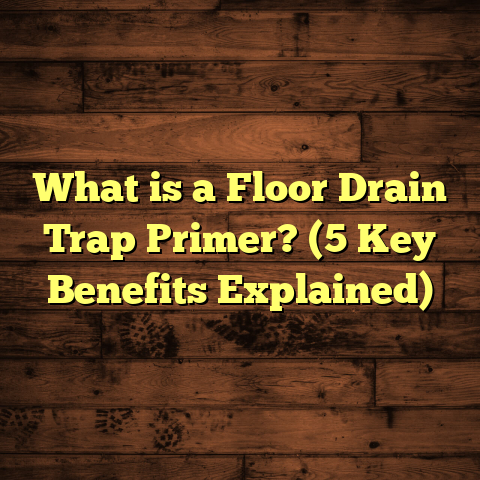What is Better: Laminate or Vinyl Wood Flooring? (5 Key Differences)
I remember the first time I walked into a flooring store, feeling a mix of excitement and confusion.
There were endless options laid out before me—laminate planks, vinyl sheets, hardwood panels, tiles, and more.
I was drawn to the look of wood but unsure which material would hold up best in my house.
Would laminate give me that authentic wood feel without blowing my budget?
Or would vinyl wood be better because of its water resistance?
I found myself asking a ton of questions and wishing someone would just lay it all out clearly for me.
If you’ve ever stood in that same spot, unsure which flooring to pick, you’re not alone.
Choosing between laminate and vinyl wood flooring is one of the most common—and often tricky—decisions in home renovation.
Both promise the warm, natural beauty of wood but come with very different features and care demands.
Over the years, working as a flooring contractor and helping countless homeowners,
I’ve learned what makes each type tick. I’ve seen how they perform in real homes, with real lives happening on them—kids running, pets scratching, spills landing unexpectedly.
So let me share what I’ve gathered from hands-on experience, research, and honest conversations with homeowners like you.
Together, we’ll explore five key differences between laminate and vinyl wood flooring that can help you decide which one fits your lifestyle and space best.
What Does It Really Mean When We Talk About Laminate and Vinyl Wood Flooring?
Before we get into comparing laminate and vinyl wood flooring side by side, let’s break down what these materials actually are.
Understanding their construction gives us clues about why they behave differently once installed.
Laminate Flooring: Layers That Tell a Story
Laminate flooring is a clever product made to mimic wood without using actual planks of solid wood.
At its core, laminate flooring has four main layers:
- Bottom Layer: A stabilizing backing that provides moisture protection from below and keeps the floor balanced.
- Core Layer: Usually made from high-density fiberboard (HDF), which is compressed wood fibers glued tightly together.
This layer provides durability and strength. - Design Layer: A high-resolution printed photograph that shows the wood grain or other patterns.
This photographic layer is what gives laminate its wood-like appearance. - Wear Layer: A transparent protective coating made from melamine resin or aluminum oxide that guards against scratches, stains, and fading.
This layered setup means laminate looks like wood but isn’t actually wood.
The design layer can reproduce just about any style—from oak to walnut to exotic tropical woods—at a fraction of the cost.
Vinyl Wood Flooring: Plastic That Imitates Nature
Vinyl wood flooring—often called luxury vinyl plank (LVP)—is made primarily from polyvinyl chloride (PVC) plastics.
Here’s how vinyl flooring breaks down:
- Backing Layer: Provides stability and sometimes cushioning.
- Core Layer: Can be rigid (WPC or SPC cores) or flexible vinyl sheets with embedded fibers.
- Design Layer: Similar to laminate, this is a printed image of wood grain or other textures.
- Wear Layer: A clear top coat that protects against scratches, scuffs, and stains.
What sets vinyl apart is its flexibility and waterproof nature.
Unlike laminate’s fiberboard core, vinyl is mostly plastic, so it won’t swell or warp when exposed to water.
Because of these differences in material makeup, laminate and vinyl behave very differently once installed.
Why Do So Many Homeowners Choose Laminate or Vinyl Wood Flooring?
You might wonder why these two engineered flooring options are so popular compared to traditional hardwood or tile.
Here’s what I’ve observed over years of talking with customers:
- Cost-Friendly: Both laminate and vinyl give you the wood-look feel without the heavy price tag of solid hardwood.
- Durability: They can withstand everyday wear better than softer woods or carpets.
- Ease of Installation: Many products feature click-lock systems that make DIY installation possible.
- Versatility: They work in spaces where hardwood might fail due to moisture or temperature changes.
- Maintenance: Both require less upkeep than real wood floors.
Despite these shared advantages, the choice between laminate and vinyl often comes down to specific needs: moisture levels in rooms, foot traffic volume, budget flexibility, style preferences, and even environmental concerns.
1. Durability and Water Resistance: The Battle Against Life’s Messes
This is where laminate and vinyl show their most obvious differences.
Laminate’s Strengths and Weaknesses
Laminate floors are pretty tough under normal living conditions. The wear layer protects against scratches from shoes or pets, and the dense core provides stability.
But here’s where laminate struggles: water.
The fiberboard core absorbs moisture quickly if spills aren’t wiped up fast. That can cause swelling, warping, or even delamination where layers separate over time.
In my early days as a flooring contractor, I installed laminate in a kitchen for a client who loved the look but underestimated how much water splashes around cooking areas. Within 6 months, several boards near the sink edges started puffing up. It was heartbreaking because laminate itself isn’t cheap once you factor in installation costs.
Statistic: According to data from the North American Laminate Flooring Association (NALFA), standard laminate floors tolerate moisture exposure for only about 12-24 hours before damage begins if water isn’t cleaned up promptly.
Vinyl’s Waterproof Edge
Vinyl’s PVC base makes it inherently waterproof. Spills, pet accidents, even flooding won’t ruin it.
This is why vinyl is often recommended for bathrooms, kitchens, basements—anywhere moisture is common.
I recall a homeowner who chose vinyl plank flooring after a flood in her basement destroyed her old carpet. Five years later, her floors still look brand new despite occasional dampness.
Tests show that luxury vinyl plank flooring can withstand continuous water exposure with zero swelling or warping. This resilience extends its lifespan dramatically compared to laminate in wet conditions.
2. Installation: How Quickly Can You Get Your Floors Done?
Installation affects your upfront costs, project timeline, and whether you can tackle it yourself.
Laminate Installation: Click-Lock Floating Floors
Laminate boards usually come with a click-lock system that allows them to snap together without glue or nails.
They “float” over the subfloor rather than being attached directly to it.
This method saves time and lets you install over many surfaces like concrete slabs or existing floors if they’re level.
When I installed laminate in my own dining room (about 400 sq ft), it took me roughly two days from prep work to final trim—mostly because I was learning as I went!
Vinyl Installation: Flexible Options
Vinyl installation varies more depending on product type:
- Click-Lock Vinyl Planks: Similar to laminate’s floating floor style; quick and easy.
- Glue-Down Vinyl: Requires adhesive application; takes longer but offers a more permanent bond.
- Sheet Vinyl: Usually glued down; less common for wood-look but popular in commercial spaces.
I’ve worked on projects where glue-down vinyl was needed for heavy commercial foot traffic areas because it won’t shift over time.
Vinyl’s flexibility also allows installation over slightly uneven subfloors where laminate might struggle without extra prep.
3. Appearance & Texture: Which Feels More Like Real Wood?
Looks matter a lot—after all, you want your floors to feel like home.
Laminate’s Visual Appeal
The photographic layer on laminate is very high-resolution nowadays.
You can find almost any wood pattern imaginable—from distressed barnwood to smooth maple.
However, because it’s printed on top of fiberboard with a plastic wear layer above it, the texture tends to be smoother than real wood.
Some laminates have embossed textures mimicking grain patterns but rarely match real wood’s tactile depth perfectly.
I once had a customer say her laminate floor looked stunning from afar but felt “too fake” when she walked barefoot on it.
Vinyl’s Realistic Textures
Vinyl planks often feature embossed-in-register (EIR) technology where the texture aligns exactly with the printed grain pattern beneath.
This means the surface feels like real wood grain underfoot—a huge plus for authenticity.
Many brands offer hand-scraped or wire-brushed finishes that look remarkably close to hardwood varieties.
Consumer preference studies show about 70% of people surveyed felt vinyl planks provided a more realistic look and feel compared to laminate samples under blind testing conditions.
4. Cost Considerations: What Fits Your Budget?
I’ve been through enough projects to know cost surprises kill momentum fast.
Here are average price ranges for materials only (per square foot):
| Flooring Type | Material Cost Range | Installation Cost Range |
|---|---|---|
| Laminate | $1.00 – $3.00 | $2.00 – $5.00 |
| Vinyl (LVP) | $2.00 – $5.00 | $2.00 – $7.00 |
Laminate usually comes out cheaper upfront but may require earlier replacement if exposed to water damage or heavy wear.
Vinyl costs more initially but can save money on repairs or replacement due to its durability and waterproof nature.
Using tools like FloorTally has been invaluable for me here—it lets me input exact square footage and select materials along with local labor rates so I get accurate cost projections fast.
It also factors in waste—typically 5-10% extra material—to avoid last-minute shortages or budget blowouts during installation.
5. Maintenance & Lifespan: Keeping It Beautiful Over Time
How your floors age depends partly on how you care for them.
Caring for Laminate
Laminate floors need some caution:
- Avoid soaking them with water; use damp mops instead.
- Don’t use harsh chemicals or abrasive cleaners.
- Clean spills promptly to prevent warping.
- Use felt pads under furniture legs to prevent scratches.
If you follow these tips rigorously, laminate floors can last 10-15 years easily under normal household use.
Caring for Vinyl
Vinyl is low-maintenance by comparison:
- Safe for wet mopping and steam cleaning.
- Resistant to stains from pets or kids.
- Can handle heavy foot traffic without visible wear for 15-20+ years.
- Doesn’t need refinishing or resealing like hardwood does.
In homes with active families or pets who track dirt inside constantly, vinyl tends to maintain its fresh appearance longer with less effort.
Real-Life Case Studies From My Work
Case Study 1: Family Home With Kids & Dogs
A couple wanted durable floors that looked warm and inviting but could handle muddy paws and spilled drinks.
They opted for vinyl plank flooring throughout the main floor—including kitchen and living room.
After 4 years, their floors show minimal wear despite heavy foot traffic daily. They love how easy cleanup is after spills or pet accidents—no swelling or staining at all.
Case Study 2: Senior Couple Seeking Quiet & Comfort
For their upstairs bedrooms where noise reduction mattered most, I recommended laminate flooring with an underlayment designed for sound absorption.
They appreciated how smooth and consistent the floors looked but mentioned that after several years, the edges near bathroom doors occasionally swelled from humidity spikes during showers—a reminder that moisture control is key with laminate.
Environmental Impact: What About Sustainability?
If you’re like me, you want floors that look good but don’t harm the planet unnecessarily.
Here’s what I found after researching:
- Laminate uses recycled wood fibers in its core layer—good news for reducing waste.
- However, adhesives and resins used can emit VOCs (volatile organic compounds), affecting indoor air quality unless certified low-emission products are chosen.
- Vinyl production involves PVC plastics derived from fossil fuels; it’s less eco-friendly but newer low-VOC options exist.
- Both types can be recycled but require special facilities not always available locally.
- Certifications like FloorScore or GREENGUARD help identify products with better indoor air quality standards.
If sustainability matters deeply to you, look closely at manufacturers’ transparency reports before committing.
Design Trends & Style Tips I’ve Seen Gain Popularity
Wood-look floors remain timeless but styles evolve:
- Wide planks are trending now more than narrow strips; they create spaciousness.
- Gray-toned woods continue growing in popularity for modern aesthetics.
- Distressed or hand-scraped textures add rustic charm without sacrificing durability.
- Mixed-width plank installations bring character to simple rooms.
- Pairing warm wood tones with cooler wall colors balances cozy yet fresh vibes nicely.
Laminate offers vast design variety thanks to printing possibilities while vinyl provides superior texture realism if tactile feel tops your list.
Troubleshooting Common Problems I’ve Helped Clients Solve
Sometimes things don’t go perfectly after installation:
- Laminate swelling near wet areas: Usually fixed by replacing damaged boards & adding moisture barriers or transition strips.
- Vinyl planks lifting or shifting: Often due to improper subfloor prep; sanding/leveling subfloor solves this.
- Scratches on laminate: Minor scratches can be buffed out carefully or repaired with color-matched kits.
- Fading colors: Both types resist UV fading well but direct sunlight exposure over years may cause slight color shifts—using blinds helps protect floors.
These issues are manageable if caught early; routine inspections help prevent bigger headaches later on.
Final Thoughts From My Toolbox
Choosing between laminate and vinyl wood flooring isn’t about picking “better” universally—it’s about finding the best fit for your home and how you live there.
The five differences we’ve covered relate closely to:
| Factor | Laminate | Vinyl Wood |
|---|---|---|
| Water Resistance | Moderate (low tolerance) | High (fully waterproof) |
| Installation Ease | Easy (floating floor) | Easy (varies by type) |
| Realism of Look & Feel | Good visual; less texture | Very close tactile match |
| Initial Cost | Lower | Moderate to higher |
| Maintenance & Longevity | Moderate maintenance | Low maintenance; longer life |
If budget is tight and moisture isn’t an issue, laminate gives great value for dry areas like bedrooms or living rooms.
If water resistance, durability under heavy use, and authentic texture top your checklist, vinyl will likely pay off long-term despite higher upfront cost.
For me personally, working with both materials over years has shown how important it is not just to pick by price or looks, but by matching product strengths with specific room conditions and lifestyle needs.
And whenever numbers start swirling around budgets, FloorTally has been my go-to tool for quick, accurate cost planning based on up-to-date local pricing. It cuts through guesswork so I can focus on delivering results clients love without financial surprises mid-project.
Would you like help estimating costs for your next project? Or maybe some tips on how to prep your subfloor perfectly? Just ask! I’m here to share what I’ve learned so far—and help make your next flooring choice easier than mine was back then.





